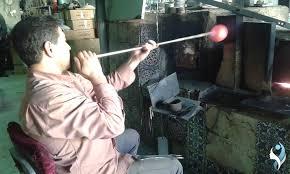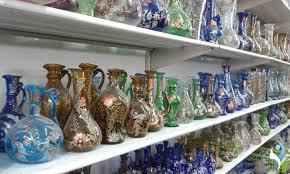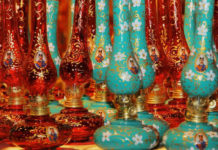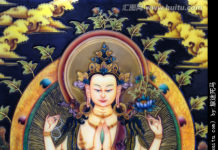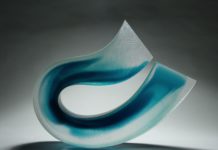It is believed that Hebron became associated with glass several centuries ago, most probably the thirteenth century. According to historical sources in the fourteenth century, there were no less than fourteen factories of glass in Hebron, all located in the old city. A special quarter was designed for this industry, which still today carries the name of glassblower (harat al-zajijeen).
According to the Islamic wakf religious documents, only three factories are still in operation. Two of them are owned by the Natsheh family. Traditionally, the raw materials were gathered from nature. Sand, which is a major component, was brought from the area of Bani Nu’aim, a village close to Hebron. Sodium carbonate was brought from the Dead Sea. And the colouring materials were prepared from metal oxides (iron, copper, etc.)
The raw material of today comes from recycled glass, which is gathered from houses in the area and brought to the factory to be smashed and then cooked. The colours of Hebron glass include dark and light blue, turquoise, dark red (Bordeaux), and light and dark green.
The techniques and methods for manufacturing glass require simple tools: furnace for melting the glass, long metal pipe, and a metal instrument (kammasha). The craftsperson holds a long, thin pipe (80-100 cm) in one hand and then puts it into the molten glass inside the furnace; he or she pulls it out with some semi-liquid glass. As he or she blows through the pipe, the form of an object appears. The shaping process continues with a metal instrument (kammasha), until the vessel is completed. The pipe is put into the furnace again, pulled back close to the mouth, and blown into in order to give shape to the object. The kammasha is used once again, to put the glass object aside into a small chamber adjacent to the furnace to cool down.
The products of this craft were functional cups of various sizes and shapes, bottles, bowls, jugs, dishes, olive oil lamps, and later, various forms of petrol lamps, which were considered common household items. Jewellery and accessories, mainly for Bedouins, were also produced and sold in the desert (the Naqab, the Arabian Desert, and the Sinai). Some of these products—namely, eyes handmade from blue glass—were used as amulets to protect people or homes from the evil eye. Glass balls were also produced for fishing nets.
Although most objects are not decorated, some have artistically applied glass strings, which add to their uniqueness. Metallic decoration is a recent innovation.
